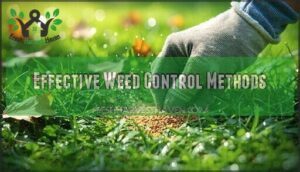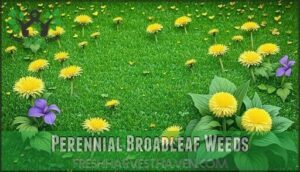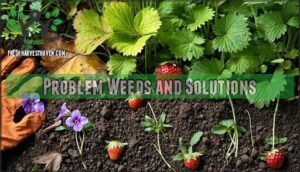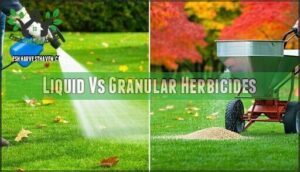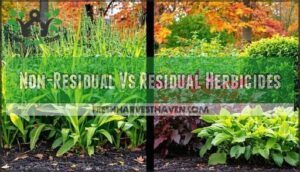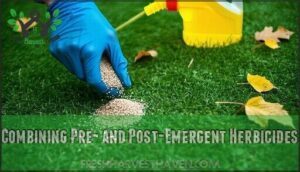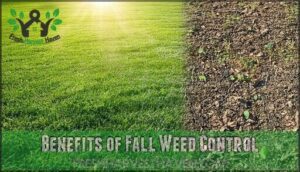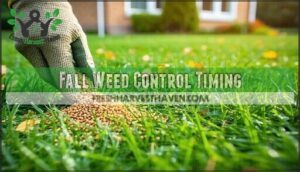This site is supported by our readers. We may earn a commission, at no cost to you, if you purchase through links.
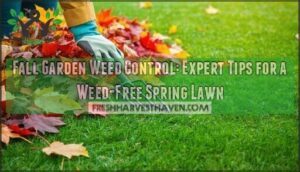 Fall garden weed control starts now to prevent spring headaches.
Fall garden weed control starts now to prevent spring headaches.
Apply pre-emergent herbicides when soil temperatures drop below 70°F to stop winter annuals like chickweed and henbit before they germinate.
You’ll also want to tackle existing perennial weeds while they’re storing energy in their roots—making herbicides more effective.
Hand-pulling works great for smaller infestations, and don’t forget mulching around plants to smother emerging weeds.
Think of fall as your secret weapon against weeds; while your neighbors battle dandelions come spring, you’ll be sipping coffee admiring your pristine lawn.
The key lies in understanding which weeds to target and when, making fall a crucial time for weed control.
Table Of Contents
- Key Takeaways
- Fall Garden Preparation
- Effective Weed Control Methods
- Fall Weed Identification
- Herbicide Application Techniques
- Manual Weed Control Strategies
- Benefits of Fall Weed Control
- Fall Weed Control Timing
- Frequently Asked Questions (FAQs)
- How to control fall weeds?
- Do I need Weed control in the fall?
- Can you kill weeds in the fall?
- What weed control products can I use in the fall?
- Can you use Weed Killer in the vegetable garden in the fall?
- When is the best time to control weeds?
- What to put down for weeds in the fall?
- Is October too late to spray for weeds?
- Is it worth spraying for weeds in the fall?
- When to apply weed preventer in fall?
- Conclusion
Key Takeaways
- Time your fall weed control perfectly – Apply pre-emergent herbicides when soil temperatures drop below 70°F to stop winter annuals like chickweed and henbit before they germinate.
- Target perennial weeds while they’re vulnerable – Attack established weeds like dandelions during fall when they’re storing energy in their roots, making herbicides more effective than spring treatments.
- Use mulching as your secret weapon – Apply a two-inch layer of organic mulch around plants to create a natural barrier that starves weeds while enriching your soil as it decomposes.
- Combine multiple control methods for maximum impact – Mix hand-pulling for small infestations, strategic herbicide applications, and proper lawn care practices to prevent up to 65% of next year’s weed problems.
Fall Garden Preparation
Your fall garden needs a solid foundation before winter arrives to prevent spring headaches.
Proper preparation through mulching, manual removal, and strategic herbicide use sets the stage for healthy growth when warmer weather returns, ensuring a strong foundation for your garden’s future success with healthy growth.
Mulching Techniques for Weed Control
Why struggle with stubborn weeds when mulch can do the heavy lifting?
Apply a two-inch layer of organic mulching materials like straw or shredded leaves around your plants for effective fall garden weed control.
Natural mulch creates a protective shield that starves weeds while feeding your soil.
This natural weed control method creates weed barriers** while providing soil insulation, enriching your garden bedding as it decomposes for superior weed prevention.
Using organic mulch products can enhance the overall organic mulch benefits in your garden.
Manual and Mechanical Weed Removal
Fifteen minutes of daily hand weeding beats hours of spring struggle.
You’ll master weed control with these essential techniques:
- Weed pulling small annuals like henbit before they establish deep roots
- Garden hoes for shallow cultivation of emerging weeds
- Fork removal of perennial crowns on wet days for easier extraction
- Handpicking with hori hori knives for precision work around desired plants
Effective gardening often involves using the right garden hoe tools to remove weeds efficiently.
Herbicide Use and Considerations
When mastering fall weed management, herbicides offer powerful chemical weed control options if you follow safety protocols.
Select the right chemical types for your target weeds, apply at proper application rates, and consider environmental impact.
Herbicide application requires precision to prevent weed resistance while ensuring herbicide safety.
Choose proven weed control methods over shortcuts.
Effective Weed Control Methods
You’ll find several effective herbicide options when targeting weeds during fall’s best control window.
Selective herbicides, pre-emergent applications, and post-emergent strategies each tackle different weed challenges, giving you the upper hand before spring growth begins.
Selective Herbicides for Fall Gardens
Selective herbicides target specific weeds while protecting your desired plants, making fall applications safer than spring treatments.
These specialized weed control methods work by disrupting biological processes in broadleaf weeds without harming grass.
4 Game-Changing Benefits of Selective Herbicides:
- Precision Targeting – Eliminate dandelions, clover, and chickweed while keeping your lawn intact
- Enhanced Safety – Fall’s cooler temperatures reduce volatility and drift risks
- Maximum Absorption – Perennial weeds transport nutrients to roots, boosting herbicide effectiveness
- Future Protection – Prevent weed resistance by rotating herbicide types seasonally
Choose formulations containing 2,4-D, MCPA, or dicamba for autumn weed control success.
For best results, verify you apply herbicides when soil moisture is adequate.
Pre-Emergent Herbicide Application
When soil temperatures drop below 70°F, you’ll want to apply pre-emergent herbicides for maximum weed prevention.
Application timing matters most—target late summer through early fall for maximum effectiveness.
| Product Type | Best Application Window | Target Weeds |
|---|---|---|
| Indaziflam (Specticle FLO) | September-October | Winter annuals, broadleaf weeds |
| Pendimethalin | Late August-September | Chickweed, henbit, annual bluegrass |
| Dithiopyr combinations | Early fall | Mixed broadleaf and grassy weeds |
| General pre-emergents | Before first frost | Germinating winter annuals |
These fall gardening tips guarantee you’re creating an invisible barrier that stops weeds before they start.
Safe handling requires following label directions precisely, while proper herbicide selection depends on your specific lawn type and target weeds.
Post-Emergent Herbicide Strategies
When weeds have already emerged, post-emergent herbicides become your go-to weed control products.
Fall’s cooler temperatures enhance herbicide translocation as weeds absorb nutrients into their roots for winter storage.
This improved weed absorption makes your weed treatment more effective than spring applications, and you should apply these weed control strategies when temperatures stay above 55°F for the best results.
Rotate herbicide types to prevent resistance management issues, and consider organic mulch benefits for long-term weed suppression.
Fall Weed Identification
Identifying the weeds in your fall garden is the first step to choosing the right control method.
You’ll encounter three main categories: winter annuals that germinate now, established perennials storing energy for winter, and persistent problem weeds that require targeted solutions.
Winter Annual Broadleaf Weeds
Now that you understand effective weed control methods, weed identification becomes your next challenge.
Winter annual broadleaf weeds like henbit, purple deadnettle, and common chickweed germinate during fall germination periods from late August through October. These autumn weeds establish quickly, creating dense mats that steal nutrients from your lawn.
Proper fall garden preparation requires recognizing these invaders early for successful prevention strategies. As growers increasingly recognize, fall-applied herbicides can provide effective weed control.
- Henbit: Heart-shaped leaves with purplish-green stems that spread rapidly across thin turf areas
- Purple deadnettle: Similar appearance to henbit but with more pronounced purple coloring and serrated leaf edges
- Common chickweed: Forms dense, mat-like colonies that can smother grass and delay spring soil warming
- Control timing: Apply herbicide timing strategies in mid-September through November when these winter annual broadleaf weeds are young and actively growing
Perennial Broadleaf Weeds
Perennial powerhouses like dandelions and plantains establish deep root system control challenges that require strategic fall herbicide timing.
These stubborn survivors store energy in their roots during autumn, making winter dormancy effects work in your favor. Identification challenges arise because many look harmless, but don’t be fooled—these autumn weeds are preparing for winter warfare against your fall lawn care efforts.
| Common Perennial Weeds | Key Identification | Control Method |
|---|---|---|
| Dandelion | Yellow flowers, serrated leaves | Post-emergent herbicide |
| Plantain | Ribbed leaves, spike flowers | Hand removal or herbicide |
| Wild Violet | Heart-shaped leaves, purple blooms | Selective broadleaf weeds treatment |
| Creeping Charlie | Round scalloped leaves, square stems | Preventative strategies with herbicide |
Perennial weeds actively move nutrients downward in fall, making weed control techniques more effective than spring applications.
Problem Weeds and Solutions
Beyond your typical dandelions and plantains, certain troublesome weeds require specialized garden weed control approaches that combine weed identification with targeted control methods.
- Wild violet – These heart-shaped beauties spread aggressively; manual removal works best before they flower
- Creeping Charlie – This mint-family invader needs post-emergent herbicide options during active fall growth
- Mock strawberry – Hand-pulling these false berries prevents spring takeover in your autumn gardening routine
- Wild onion/garlic – Their waxy coating resists most weed control techniques; repeated seasonal strategies prove most effective
Herbicide Application Techniques
When you’re ready to apply herbicides in your fall garden, you’ll need to choose between liquid and granular formulations based on your specific weed problems and application preferences.
Understanding the differences between residual and non-residual herbicides, plus how to effectively combine pre- and post-emergent treatments, will help you create a thorough weed control strategy that works through winter and into spring.
Liquid Vs Granular Herbicides
Choosing between liquid herbicides and granular herbicides for fall season weed control depends on your priorities.
Liquid herbicides offer superior coverage uniformity and weed adherence, making them more effective against stubborn weeds.
However, granular herbicides provide easier application methods and often include fertilizer combinations.
Consider cost analysis and environmental impact when selecting your herbicide option for the best results; for example, some gardeners prefer vinegar based herbicides for their reduced environmental impact.
Non-Residual Vs Residual Herbicides
When selecting herbicides for fall season weed control, you’ll encounter two distinct categories that behave differently in your soil.
Non-residual herbicides work fast but disappear quickly, while residual options provide lasting weed prevention strategies through herbicide persistence.
- Quick knockdown power – Non-residual herbicides eliminate existing weeds within days
- Long-term protection – Residual herbicides create months of soil impact against new weeds
- Flexible timing – Non-residual options allow immediate replanting without application timing concerns
- Season-long defense – Residual herbicides prevent weed resistance by stopping germination cycles
- Environmental peace of mind – Both types address environmental concerns when used properly
Combining Pre- and Post-Emergent Herbicides
Combining herbicides creates powerful herbicide synergies that boost your fall season weed control timing.
You’ll maximize cost efficiency by targeting existing weeds with post-emergents while preventing future germination with preemergents.
This dual approach improves resistance management and reduces environmental impact compared to repeated single-herbicide applications throughout the year, which enhances overall cost efficiency.
Manual Weed Control Strategies
Manual weed control offers the most precise and environmentally friendly approach to maintaining your fall garden without relying on chemicals.
You’ll achieve better long-term results by combining physical removal techniques with strategic mulching and lawn care practices that strengthen your garden’s natural defenses, using environmentally friendly methods to maintain your garden.
Hoeing and Pulling Weeds
Always start your fall garden weed control by identifying which weeds you’re battling.
Hand-pulling techniques work best on smaller weeds when soil’s moist—you’ll get complete root removal without breaking stems.
Use proper tool selection: hori hori knives for precision work, garden forks for stubborn perennials.
Hoeing methods target shallow-rooted annuals effectively, disrupting their growth before they establish deep root systems, which is a key aspect of complete root removal and using the right tools like garden forks.
Mulching and Overseeding
Your autumn lawn care strategy isn’t complete without proper mulch types and overseeding benefits.
Apply a two-inch mulch depth around plants to block weed seeds during the fall season.
Timing overseeding correctly—before frost—gives new grass a competitive edge.
Choose quality seed selection for your climate, then mulch lightly over seeded areas using effective weed prevention techniques.
Consider soil solarization techniques for pre-planting weed control.
Lawn Health Improvement Strategies
Beyond mulching and overseeding, you’ll want to focus on thorough lawn health improvement strategies that create an environment where grass thrives and weeds struggle.
Soil aeration breaks up compacted earth, allowing roots to breathe and absorb nutrients more effectively.
Fall fertilization provides essential nutrients for root development during cooler months.
Proper watering practices – deep, infrequent sessions – encourage strong root systems while preventing shallow-rooted weeds from establishing.
These autumn lawn care approaches work together, forming a foundation for disease prevention and long-term weed control strategies, which help in creating an environment where grass thrives and weeds struggle, ultimately leading to lawn health improvement.
Benefits of Fall Weed Control
Fall weed control sets you up for success by stopping weeds before they become a spring nightmare.
You’ll prevent seed production now, which means fewer weeds competing with your grass when growing season returns, this can be seen as a way to achieve success.
Reducing Spring Weed Growth
You’ll dramatically reduce next year’s weed battles through strategic fall intervention.
Early action against emerging weeds disrupts their life cycle management, preventing extensive root system establishment before winter dormancy.
- Dormancy Prevention: Target active weeds before they enter winter survival mode
- Seedbank Reduction: Eliminate weed seeds before spring germination cycles begin
- Root System Weakening: Disrupt perennial weeds when they’re moving nutrients downward
- Early Intervention: Stop winter annuals during vulnerable establishment phases
- Long-Term Solutions: Create lasting seasonal weed prevention through autumn weed control tips
Preventing Weed Seed Production
Most weeds drop their seeds between September and early November, so stopping seed production now prevents next year’s headaches.
You’ll cut future weed populations by up to 65% with timely intervention before those sneaky seed heads mature.
| Technique | Timing | Effectiveness |
|---|---|---|
| Seed Head Removal | Before flowering | Blocks 100% seed production |
| Preemptive Mowing | Late summer | Reduces seed bank by 65% |
| Fall Tillage | Post-harvest | Prevents 80% seed viability |
| Weed Barriers | Early autumn | Suppresses 98% emergence |
Creating a Healthy and Lush Lawn
Success comes from building lawn resilience through strategic fall practices.
Start soil testing to identify nutrient deficiencies, then implement fall fertilization for robust spring growth.
Your autumn lawn care strategy should include:
- Lawn aeration to improve root penetration and water absorption
- Overseeding practices in thin areas for denser turf coverage
- Proper watering schedules that support deep root development.
These lawn health tips create competition against weeds naturally.
Fall Weed Control Timing
Timing your fall weed control correctly makes the difference between a weed-free spring lawn and months of extra work ahead.
You’ll want to target late summer through early fall when weeds are actively growing but before they go dormant for winter, which is a critical time for effective control.
Optimal Timing for Weed Control
Timing your fall weed control correctly means the difference between a pristine spring lawn and a weedy mess.
You’ll want to target those critical Application Windows when soil temperatures hit specific Temperature Thresholds—typically when temps drop to 55-60°F for five consecutive days.
This triggers Seasonal Germination of winter annuals, making Herbicide Effectiveness peak during these narrow windows.
Fall gardeners can also extend their harvest by using simple protection methods.
| Control Method | Optimal Timing |
|---|---|
| Pre-emergent herbicides | Late August to early September |
| Post-emergent treatments | Early to mid-October |
| Manual weed removal | September through November |
| Mulching application | After October weeding |
| Soil cultivation | Late summer before emergence |
Understanding Weed Life-cycles helps you strike when weeds are most vulnerable—before they establish deep roots or go dormant.
Factors Affecting Weed Growth in Fall
Several environmental factors influence how weeds behave during autumn months.
Understanding these conditions helps you time your seasonal weed control efforts for maximum effectiveness.
Key factors that affect fall weed germination and growth include:
- Soil Temperature – Cooler temperatures trigger weed seeds to sprout, especially when soil drops below 70°F
- Sunlight Exposure – Shorter daylight hours slow growth but don’t stop seed germination completely
- Moisture Levels – Fall rains create ideal conditions for soil moisture and weed life cycle activation
- Nutrient Availability – Decomposing organic matter provides nutrients that fuel weed development
- Weed Germination – Many winter annuals begin their life cycle during autumn’s mild weather conditions
Precautions to Take When Using Weed Killer in Fall
When applying weed killer, check weather conditions first—avoid windy days and temperatures below 55°F.
Perfect weather isn’t guaranteed—plan your weed control around Mother Nature’s schedule, not yours.
Wear protective gear including gloves and eye protection for herbicide safety. Follow application rates precisely to prevent herbicide resistance and plant sensitivity issues.
Don’t treat newly seeded areas or stressed lawns. These weed killer precautions guarantee effective lawn treatment while maintaining lawn safety throughout your fall weed control program, ensuring a successful outcome with lawn safety.
Frequently Asked Questions (FAQs)
How to control fall weeds?
Seventy-five percent of weeds germinate in fall, making timing vital.
You’ll control weeds effectively by hand-pulling small ones, applying pre-emergent herbicides before germination, and mulching around plants to block sunlight and prevent new growth.
Do I need Weed control in the fall?
Yes, you absolutely need fall weed control! Fall’s your best window for targeting perennial weeds when they’re storing energy in roots, making herbicides more effective than spring treatments.
Can you kill weeds in the fall?
You can definitely kill weeds in fall.
It’s actually one of the best times because perennial weeds are storing energy in their roots, making herbicides more effective at targeting the entire plant system.
What weed control products can I use in the fall?
Ironically, when gardeners assume fall means "game over" for weed control, you’ve got prime time for herbicide action.
Use pre-emergent herbicides like pendimethalin or broadleaf post-emergent treatments targeting actively growing perennials.
Can you use Weed Killer in the vegetable garden in the fall?
You can use selective herbicides in vegetable gardens during fall, but avoid them near edible crops. Hand-pulling, mulching, and cultivation work better for food gardens.
When is the best time to control weeds?
Like a skilled gardener timing their harvest, you’ll get best results controlling weeds during active growth periods.
Target weeds in late summer to early fall when they’re absorbing nutrients into roots, making herbicides most effective.
What to put down for weeds in the fall?
Apply pre-emergent herbicides in late summer to early fall before soil temps drop below 70°F. Use mulch like straw or wood chips for natural suppression.
Is October too late to spray for weeds?
October isn’t too late for broadleaf weed control if temperatures stay above 55°F. You’ll catch winter annuals before they establish, though effectiveness decreases as weeds slow growth in cooler weather.
Is it worth spraying for weeds in the fall?
Picture your lawn as a battlefield where stubborn weeds plot their winter takeover.
Yes, fall spraying’s absolutely worth it!
You’ll catch weeds when they’re vulnerable, moving nutrients to roots, making herbicides incredibly effective for long-term control.
When to apply weed preventer in fall?
You’ll want to apply pre-emergent weed preventer in late summer to early fall, ideally before soil temperatures drop below 70°F, targeting those sneaky winter weeds before they germinate.
Conclusion
Like a well-timed chess move, effective fall garden weed control sets you up for victory months before the game begins.
You’ve learned that targeting weeds now—when they’re vulnerable and before they establish—saves countless hours of spring frustration.
By applying pre-emergent herbicides at the right soil temperature, manually removing stubborn perennials, and maintaining proper mulching practices, you’re investing in a healthier lawn ecosystem.
Remember, successful fall garden weed control isn’t just about eliminating current problems; it’s about preventing future ones from taking root, and this approach is crucial for a healthier lawn ecosystem.
- https://forages.oregonstate.edu/nfgc/eo/onlineforagecurriculum/instructormaterials/availabletopics/weeds/lifecycle
- https://grow.ifa.coop/agronomy/target-perennial-weeds-this-fall
- https://www.domyown.com/why-use-fall-preemergents-a-693.html
- https://www.gardeningknowhow.com/plant-problems/weeds/how-to-kill-weeds-in-fall
- https://www.horizononline.com/best-pre-emergent-post-emergent-herbicides-fall/

